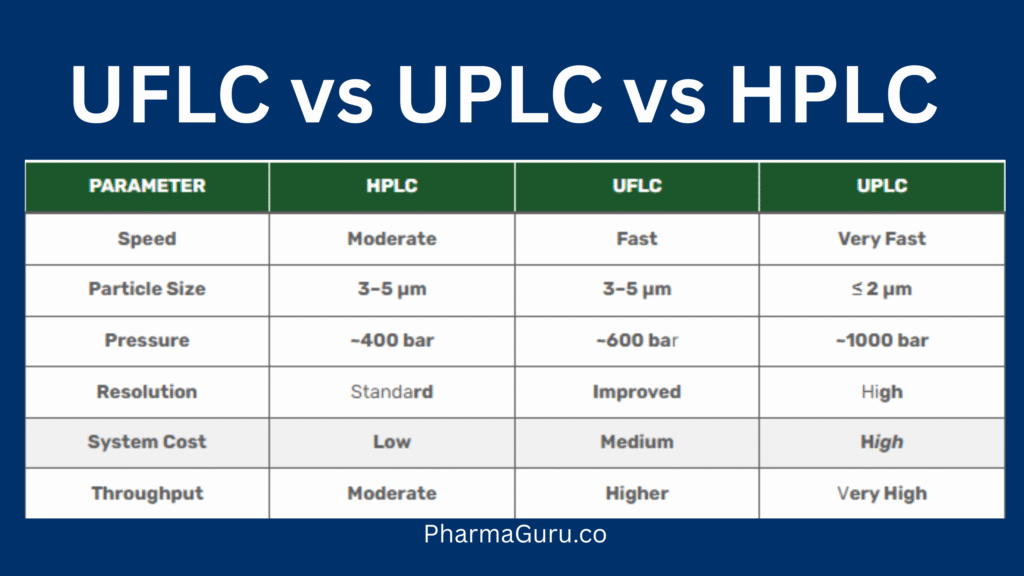UFLC vs UPLC vs HPLC: FAQs 8. Why is UFLC sometimes more practical than UPLC? UFLC offers a balance between speed and cost. It uses standard particle sizes (like HPLC) but with optimized hardware for faster runs, without requiring ultra-high pressure. It’s more cost-effective and compatible with traditional methods. 9. How do I choose between […]

HPLC uses larger particle size columns (3–5 µm) and operates at lower pressures (~400 bar), while UPLC uses sub-2 µm particle size columns and runs at much higher pressures (~1000 bar), resulting in faster, more efficient, and higher resolution separations.
The main difference lies in particle size and operating pressure:
1. HPLC: 3–5 µm particles, standard pressure
2. UPLC/UFLC: ≤2 µm particles (UPLC) or optimized 3–5 µm (UFLC), higher pressure
This allows faster analysis and better resolution in UPLC/UFLC compared to HPLC.
UPLC uses smaller column particles and higher pressure, which improves mass transfer and reduces analysis time significantly — often delivering results in 1–10 minutes vs. 10–30 minutes in HPLC.
UPLC systems require advanced hardware to handle high pressures (up to 1000 bar), precise flow control, and specialized detectors, making them more costly in terms of instrument, maintenance, and columns.
UPLC typically offers better sensitivity due to narrower peak widths, higher resolution, and reduced dispersion, leading to improved signal-to-noise ratio compared to HPLC and UFLC.
Yes. UPLC is a trademark of Waters Corporation and is a type of UHPLC (Ultra High Performance Liquid Chromatography). Other brands use terms like UHPLC or Rapid Resolution LC for similar high-pressure systems.
Yes, HPLC methods can be run on UPLC systems, provided:
You use compatible flow rates and pressure settings.
You install an HPLC column (3–5 µm).
Adjustments may be needed for system delay volume and detector settings.
UFLC offers a balance between speed and cost. It uses standard particle sizes (like HPLC) but with optimized hardware for faster runs, without requiring ultra-high pressure. It’s more cost-effective and compatible with traditional methods.
| Need | Best Choice |
|---|---|
| Routine analysis, cost-effective | HPLC |
| Faster results, same particles | UFLC |
| Highest sensitivity & resolution | UPLC |
| Complex separations or high throughput | UPLC |
| Compatibility with old methods | HPLC or UFLC |
.You May Like
| Parameter | HPLC (High Performance Liquid Chromatography) | UFLC (Ultra Fast Liquid Chromatography) | UPLC (Ultra Performance Liquid Chromatography) |
|---|---|---|---|
| Full Form | High Performance Liquid Chromatography | Ultra Fast Liquid Chromatography | Ultra Performance Liquid Chromatography |
| Column Particle Size | 3 – 5 µm | 3 – 5 µm | ≤ 2 µm (typically 1.7 µm) |
| Pressure Limit | Up to ~400 bar (6000 psi) | Up to ~600 bar (8700 psi) | Up to ~1000 bar (15,000 psi) |
| Speed of Analysis | Moderate (10–30 min typical run time) | Faster than HPLC (5–15 min) | Very fast (1–10 min) |
| Resolution | Moderate | Improved compared to HPLC | High resolution due to smaller particle size |
| Sensitivity | Moderate | Slightly better than HPLC | High sensitivity |
| Instrument Requirement | Standard HPLC system | Modified HPLC (optimized for faster analysis) | Specialized UPLC system with high-pressure capability |
| Cost (Instrument) | Lower | Moderate | Higher |
| Column Cost | Lower | Moderate | Higher (due to specialized packing and pressure limits) |
| Sample Throughput | Low to Moderate | Moderate | High |
| Application Suitability | Routine analysis | Fast routine analysis | High-throughput, method development, complex samples |
| Example Vendor | Agilent, Shimadzu, Waters | Shimadzu UFLC | Waters Acquity UPLC, Thermo Vanquish |
UPLC is best for high-resolution, fast, and sensitive pharmaceutical analysis, ideal for complex samples and high-throughput labs.
UFLC is faster than HPLC and more cost-effective than UPLC, making it great for routine QC with moderate speed and resolution needs.
HPLC is reliable, widely accepted, and budget-friendly, suitable for standard testing where speed and ultra-high sensitivity are not critical.
Expert Tips: Best overall: UPLC, but UFLC or HPLC may be more practical for routine use.
Further Reading:
Quick Links